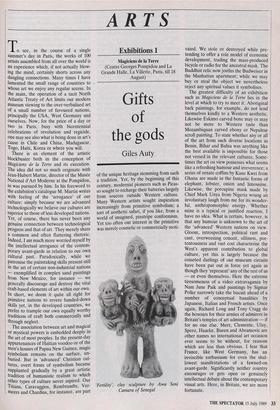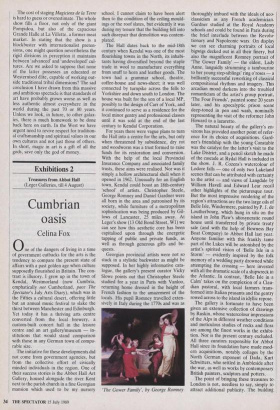ARTS
Exhibitions 1
Magiciens de la Terre (Centre Georges Pompidou and La Grande Halle, La Villette, Paris, till 18 August)
Gifts of the gods
Giles Auty
o see, in the course of a single summer's day in Paris, the works of 100 artists assembled from all over the world is an experience which, if not actually blow- ing the mind, certainly shorts across any dangling connections. Many times I have lamented the small range of countries to whose art we enjoy any regular access. In the main, the operation of a tacit North Atlantic Treaty of Art limits our modern museum viewing to the over-verbalised art of a small number of favoured nations, principally the USA, West Germany and ourselves. Now, for the price of a day or two in Paris, busy with bicentennial celebrations of revolution and regicide, one may see also what is being done in art's cause in Chile and China, Madagascar, Togo, Haiti, Korea or where you will.
There is an element of the artistic blockbuster both in the conception of Magiciens de la Terre and its execution. The idea did not so much originate with Jean-Hubert Martin, director of the Musee National d'Art Moderne at the Pompidou, as was pursued by him. In his foreword to the exhibition's catalogue M. Martin writes with feeling of the 'arrogance' of our culture: simply because we are advanced technologically we believe our cultures are superior to those of less developed nations. Yet, of course, there has never been any genuine connection between technological progress and that of art. They merely share a common and often flattering rhetoric. Indeed, I am much more worried myself by the intellectual arrogance of the contem- porary avant-garde in relation to our own cultural past. Paradoxically, while we patronise the painstaking skills present still In the art of certain non-industrial nations — exemplified in complex sand paintings from New Mexico, for instance — we generally discourage and destroy the vital craft-based elements of art within our own. In short, we deem it quite all right for Primitive nations to revere handed-down skills yet, in the developed countries, we prefer to trample our own equally worthy traditions of craft both commercially and through neglect. The association between art and magical or mystical powers is embedded deeply in the art of most peoples. In the present-day appurtenances of Haitian voodoo or of the men's houses of Papua New Guinea, magic symbolism remains on the surface, un- buried. But in 'advanced' Christian cul- tures, overt forms of symbolism became supplanted gradually by a great artistic tradition of humanistic realism to which other types of culture never aspired. Our Titians, Caravaggios, Rembrandts, Ver- meers and Chardins, for instance, are part of the unique heritage stemming from such a tradition. Yet, by the beginning of this century, modernist pioneers such as Picas- so sought to recharge their batteries largely from sources outside Western culture. Many Western artists sought inspiration increasingly from primitive symbolism; a sort of aesthetic safari, if you like, from a world of imagined, pinstripe conformism. Yet too often our interest in the primitive was merely cosmetic or commercially moti- `Fertility', clay sculpture by Camara of Senegal Awa Seni vated. We stole or destroyed while pre- tending to offer a role model of economic development, trading the mass-produced bicycle or radio for the ancestral mask. The Buddhist relic now jostles the Buthireiser in the Manhattan apartment; while we may buy or steal the object we nevertheless reject any spiritual values it symbolises.
The greatest difficulty of an exhibition such as Magiciens de la Terre lies in the level at which to try to meet it. Aboriginal bark paintings, for example, do not lend themselves kindly to a Western aesthetic. Likewise Eskimo carved bone may or may not be more to Western taste than Mozambiquan carved ebony or Nepalese scroll painting. To state whether any or all of the art from such diverse locations as Benin, Bihar and Bahia was anything like the best available is impossible for those not versed in the relevant cultures. Some- times the art on view possesses what seems like a refreshing humour and irreverence; a series of ornate coffins by Kane Kwei from Ghana are made in the fantastic forms of elephant, lobster, onion and limousine. Likewise, the porcupine mask made by Chief Mark Unya from Nigeria wrung an involuntary laugh from me for its wonder- ful, anthropomorphic energy. Whether mine is a typical or justified reaction, I have no idea. What is certain, however, is that any humour is unknown to the art of the 'advanced' Western nations on view. Gloom, introspection, political rant and cant, overweening conceit, silliness, por- tentousness and vast cost characterise the West's apparent contribution to global culture, yet this is largely because the cosseted darlings of our museum circuits have been put out in force yet again as though they 'represent' any of the rest of us — or even themselves. Here the extreme tiresomeness of a video extravaganza by Nam June Paik and paintings by Sigmar Polke narrowly take the biscuit ahead of a number of conceptual banalities by Japanese, Italian and French artists. Once again, Richard Long and Tony Cragg do the honours for their armies of admirers in Britain's temples of art administration — if for no one else. Merz, Clemente, Ulay, Spero, Haacke, Buren and Abramovic are other names no international art occasion ever seems to be without, for reasons which are less than obvious. I fear that France, like West Germany, has an invincible enthusiasm for even the shal- lowest manifestations of a fawned-on avant-garde. Significantly neither country encourages or gets open or genuinely intellectual debate about the contemporary visual arts. Here, in Britain, we are more fortunate. The cost of staging Magiciens de la Terre is hard to guess or overestimate. The whole show fills a floor, not only of the giant Pompidou, but also of the capacious Grande Halle at La Villette, a former meat market. In stating that the show is a blockbuster with internationalist preten- sions, one might question nevertheless the rigid divisions in perception it maintains between 'advanced' and 'undeveloped' cul- tures. Are we asked to suppose that none of the latter possesses an educated or Westernised elite, capable of working out- side traditional tribal dimensions? The sad conclusion I have drawn from this massive and ambitious spectacle is that standards of art have probably grown worse as well as less authentic almost everywhere in the world during the past 70 or 80 years. Unless we look, in future, to other galax- ies, there is much homework to be done back here on earth. In the West we have urgent need to revive respect for tradition- al craftsmanship and spiritual values in our own cultures and not just those of others. In short, magic in art is a gift of all the gods, save only the god of money.



















































 Previous page
Previous page